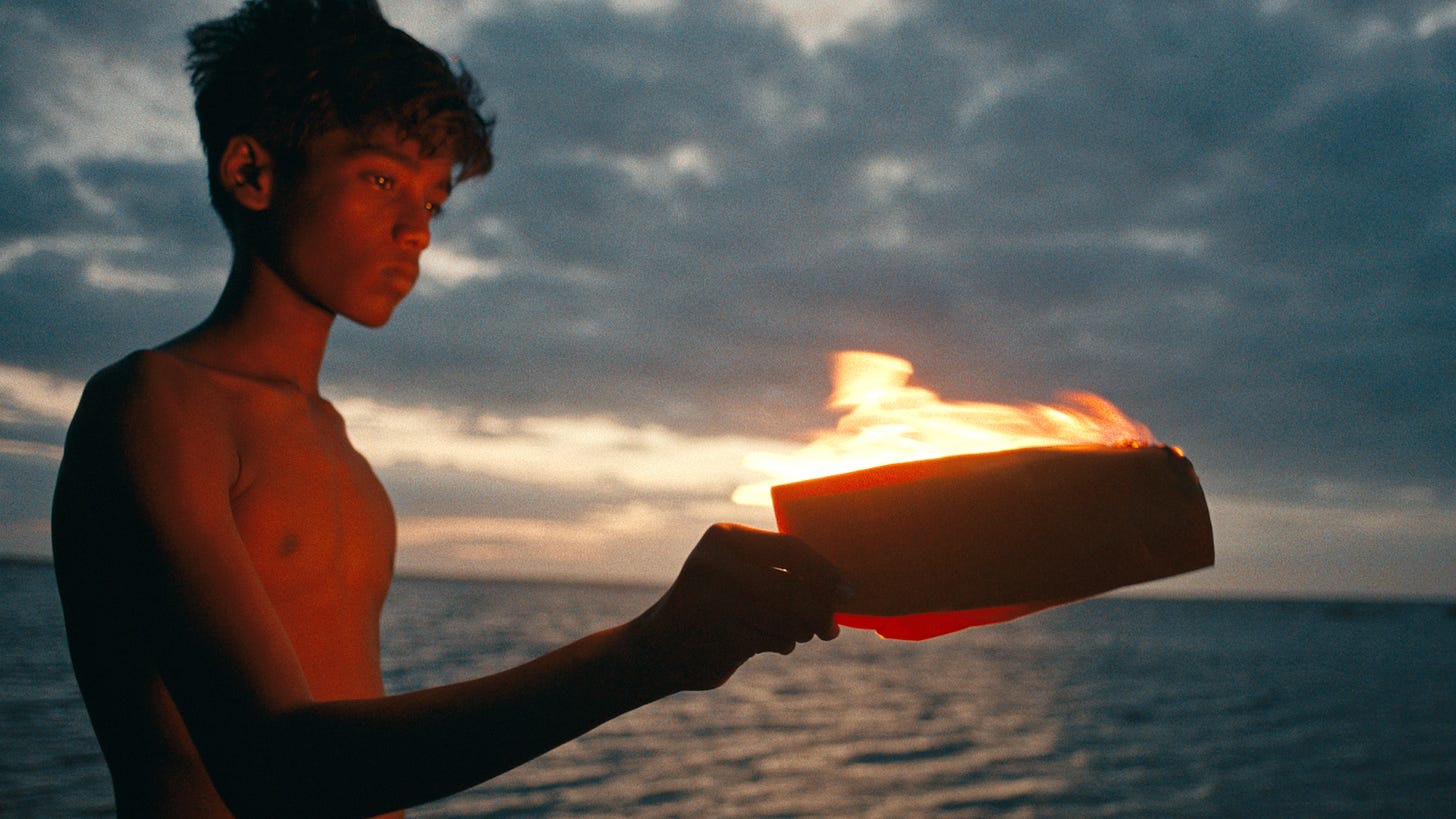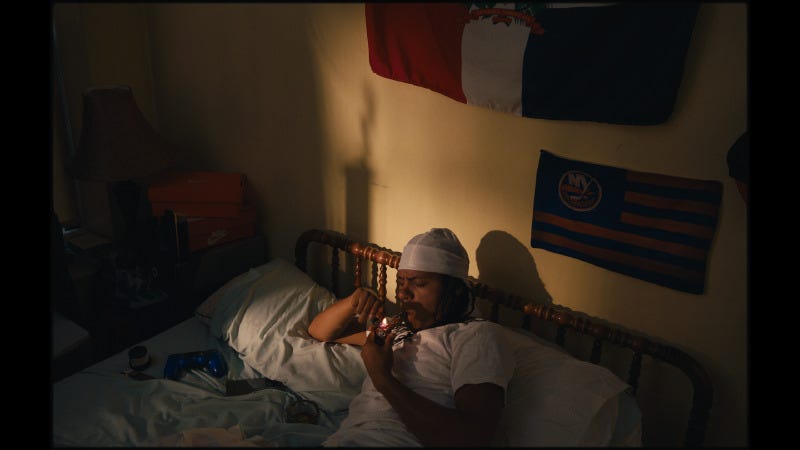VIFF Capsules: Your Touch Makes Others Invisible, Mad Bills to Pay, Blue Heron
Three feature debuts kick off my VIFF coverage
Your Touch Makes Others Invisible (Rajee Samarasinghe)
Your Touch Makes Others Invisible, the feature debut from Rajee Samarasinghe, is an avant-doc about the legacy of political disappearances in Sri Lanka. Between snippets of standard interviews, Samarasinghe tackles the toll of these unresolved tragedies through a diverse set of formal techniques, namely static tableaus, drone footage, and speculative narrative. This approach to contentious history is now rather commonplace (see: Orlando: My Political Biography, The Ballad of Suzanne Cesaire), and while Samarasinghe’s film failed to register to me as much more than a gorgeously-shot but ultimately very standard festival film, it’s not without its merits.
Oddly enough, what I found most striking was the inclusion of conventional interviews. As a woman whose son was disappeared describes her prolonged suffering, her words stand in direct contrast to an interview with former president Mahinda Rajapaksa, who describes all reports of disappearances as propaganda. Her testimony also adds more weight to the tableaus, many of which feature younger subjects looking directly at the camera. In these instances, Your Touch is a film of confrontation, and while I question if the intended recipients of this film will ever see it, I am sympathetic to any project that asserts a sense of right and wrong when historical narratives are actively being manipulated.
Your Touch Makes Others Invisible plays at VIFF on October 9th and 12th.
Mad Bills to Pay (or Destiny, dile que no soy malo) (Jose Alfonso Vargas):
In José Alfonso Vargas’ Mad Bills to Pay (or Destiny, dile que no soy malo), Rico, a 19 year-old “nutties” vendor in the Bronx gets Destiny, his underage girlfriend, pregnant, and subsequently comes to terms with newfound adult responsibilities. While many American independent films would choose to direct this premise as a quirky, heartwarming tale of self-actualization, or alternatively as a dour social-realist drama, Mad Bills to Pay takes an arthouse swerve, shooting successive sequences of antic arguments between the couple and their families in off-kilter master shots.
Vargas’ film is an enticing marriage of two disparate sensibilities - on one hand, an In Vanda’s Room inspired docu-fiction about a Dominican community forced to the margins of American society, and on the other, a freeform comedy of boisterous emotional jousting. Character development and plot-progression are all secondary to establishing the atmosphere of life in the Bronx. Wonderfully acted, impeccably directed, and endlessly charismatic, it’s an undeniable film.
As noted in this earlier review at Filmmaker Magazine, Mad Bills to Pay stands with titles such as Blue Sun Palace, and the films of the Omnes Collective as part of a new generation of indies applying the language of global cinema to American filmmaking. Seen as a group, what’s glaring about Mad Bills to Pay is that while it has arguably the most high-profile financial backing (Christine Vachon’s Killer Films), it still doesn’t have distribution. Is this more grounded master shot-mode simply less fashionable than the more overtly lyrical reference points of the other films? Do distributors view a film about an Afro-Latino community as less financially viable because of the demographics of arthouse audiences, which tend to be overwhelmingly White and Asian? It feels indicative of where the industry is that an American film as good as Mad Bills to Pay, with this pedigree and a berth at two of the world’s largest festival markets (Sundance, Berlin), could walk away without a deal.
Mad Bills to Pay (or Destiny, dile que no soy malo) plays at VIFF on October 2nd, 4th, and 10th.
Blue Heron (Sophy Romvari):
Sophy Romvari’s autobiographical feature debut, Blue Heron, opens with a meta-cinematic maneuver, immediately placing it as a continuation of a decade of short-form work that explores filmmaking as a means to process personal history. As Romvari’s adult stand-in zooms into a shot of Vancouver Island on her iPhone, she describes an inability to remember her childhood, specifically the memories of her older brother. Eventually taking the perspective of Romvari’s phone, Blue Heron self-consciously plunges into the past, recreating a fragmented version of Romvari’s youth.
In the filmed account, a family of Hungarian immigrants moves to Vancouver Island. Amidst days exploring the rocky coastal beaches and making latkes with her mother, young Sasha observes the increasingly troubled behavior from her eldest stepbrother, Jeremy. Jeremy’s behavior is less erratic that inscrutable, his lashing out, mostly in the form of obnoxiously throwing a basketball against the house or the sound of smashing a window in the middle of the night, rendered as stoic and impulsive.
The first half of Blue Heron impressionistically jumps throughout episodes of the family’s daily life until Jeremy’s eventual placement in a foster home. Romvari’s approach uses metonymic suggestion to convey the past as rich beyond cinematic comprehension, spilling beyond the confines of the frame. Romvari’s searching, constantly zooming camera combines self-reflexive movement with dense overstimulation, as seen in her ample use of reflective distortions and multiple planes of motion. In standout sequences such as a breakfast where conversation is routinely interrupted by the rapid-fire sounds and insert shots of a cereal box, these constellatory visual elements suddenly find themselves competing for primacy with equally rich sound design. Romvari’s cinema has the rush of fixation, and Blue Heron sometimes plays as if Pialat’s sensitive treatment of a similarly troubled child in L’Enfance Nue (which Romvari eventually quotes) were filtered through a disjunctive memory film.
Had Blue Heron continued in this mode, it would be one of my favorite films of the year. The decades-spanning leap that occurs midway through the film is a bit frustrating, laying out thematic threads (the use of screens, mirrors, and windows as recursive processing loops, the constructed nature of the diegesis, the incomprehensibility of Jeremy’s pain) that had already been beautifully articulated. This move to the present-day, where Sasha shoots and edits a documentary film of a case study where social workers struggle to discuss Jeremy’s case, is intentionally more sterile, reflecting the limited attention we can give to our surroundings in the moment. Perhaps the bifurcation is a way for Romvari to instill the tragic grip of the past into Blue Heron’s text, but I can’t help but feel like the effect would be stronger if we were simply left with absence.
Blue Heron plays at VIFF on October 4th and 5th




